Monthly Archives: March 2017
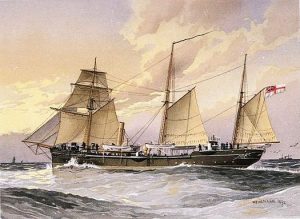 Some wars can last for years and years, while others are relatively short lived, but no war, at least to date, has been as short as the Anglo-Zanzibar War that was fought on August 27, 1896. The war was so short, that it is estimated to have lasted between 38 and 40 minutes…yes, I said minutes. The cause of the war was the sudden and unexplained death of pro-British Sultan Hamad bin Thuwaini, followed by the subsequent succession of Sultan Khalid bin Barghash, who was suspected of killing his uncle in order to take over. The British authorities preferred Hamud bin Muhammed, who was well known for his favorable stance toward British interests. A treaty signed in 1886, called for any candidate for accession to the sultanate, to be approved by the British consul, and Khalid had not fulfilled this requirement. The British considered this an act of war and sent an ultimatum to Khalid demanding that he order his forces to stand down and leave the palace. In response, Khalid called up his palace guard and barricaded himself inside the palace.
Some wars can last for years and years, while others are relatively short lived, but no war, at least to date, has been as short as the Anglo-Zanzibar War that was fought on August 27, 1896. The war was so short, that it is estimated to have lasted between 38 and 40 minutes…yes, I said minutes. The cause of the war was the sudden and unexplained death of pro-British Sultan Hamad bin Thuwaini, followed by the subsequent succession of Sultan Khalid bin Barghash, who was suspected of killing his uncle in order to take over. The British authorities preferred Hamud bin Muhammed, who was well known for his favorable stance toward British interests. A treaty signed in 1886, called for any candidate for accession to the sultanate, to be approved by the British consul, and Khalid had not fulfilled this requirement. The British considered this an act of war and sent an ultimatum to Khalid demanding that he order his forces to stand down and leave the palace. In response, Khalid called up his palace guard and barricaded himself inside the palace.
At 9:00am East Africa Time on 27 August, the ultimatum expired. The British had gathered three cruisers, two gunboats, 150 marines and sailors, and 900 Zanzibaris in the harbor area. The Royal Navy contingent were  under the command of Rear-Admiral Harry Rawson while their Zanzibaris were commanded by Brigadier-General Lloyd Mathews of the Zanzibar army, who was also the First Minister of Zanzibar. Around 2,800 Zanzibaris defended the palace, most of whom were recruited from the civilian population, but they also included the sultan’s palace guard and several hundred of his servants and slaves. The defenders had several artillery pieces and machine guns, which were set in front of the palace sighted at the British ships. The first bombardment, launched at 9:02am quickly set the palace on fire, disabling the defending artillery. A small naval action took place in the harbor, with the British sinking the Zanzibari royal yacht HHS Glasgow and two smaller vessels. The palace fired some shots ineffectually at the pro-British Zanzibari troops as they approached the palace. The flag at the palace was shot down and fire ceased at 9:40am. It was almost a matter of ready…aim…oh, never mind.
under the command of Rear-Admiral Harry Rawson while their Zanzibaris were commanded by Brigadier-General Lloyd Mathews of the Zanzibar army, who was also the First Minister of Zanzibar. Around 2,800 Zanzibaris defended the palace, most of whom were recruited from the civilian population, but they also included the sultan’s palace guard and several hundred of his servants and slaves. The defenders had several artillery pieces and machine guns, which were set in front of the palace sighted at the British ships. The first bombardment, launched at 9:02am quickly set the palace on fire, disabling the defending artillery. A small naval action took place in the harbor, with the British sinking the Zanzibari royal yacht HHS Glasgow and two smaller vessels. The palace fired some shots ineffectually at the pro-British Zanzibari troops as they approached the palace. The flag at the palace was shot down and fire ceased at 9:40am. It was almost a matter of ready…aim…oh, never mind.
Sultan Khalid bin Barghash’s forces sustained roughly 500 casualties, while the British only had one sailor injured. Sultan Khalid immediately ran to the German consulate, where he was given asylum and then he escaped to German East Africa, located in the mainland part of present day Tanzania. The British quickly placed Sultan Hamud bin Muhammed in power at the head of a puppet government. The war marked the end of the Zanzibar Sultanate as a sovereign state and the start of a period of heavy British influence. The badly damaged palace complex was completely changed by the war. The harem, lighthouse and palace were demolished as the 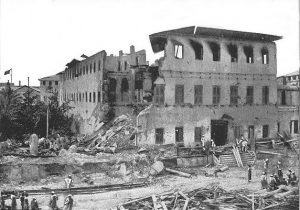 bombardment had left them unsafe. The palace site was turned into an area of gardens, and a new palace was erected on the site of the harem. The House of Wonders was almost undamaged and would later become the main secretariat for the British governing authorities. During renovation work on the House of Wonders in 1897, a clock tower was added to its frontage to replace the lighthouse lost to the shelling. The wreck of the Glasgow remained in the harbor in front of the palace, where the shallow waters ensured that her masts would remain visible for several years to come, as a reminder of what would happen if the treaty was not followed. In 1912, it was finally broken up for scrap.
bombardment had left them unsafe. The palace site was turned into an area of gardens, and a new palace was erected on the site of the harem. The House of Wonders was almost undamaged and would later become the main secretariat for the British governing authorities. During renovation work on the House of Wonders in 1897, a clock tower was added to its frontage to replace the lighthouse lost to the shelling. The wreck of the Glasgow remained in the harbor in front of the palace, where the shallow waters ensured that her masts would remain visible for several years to come, as a reminder of what would happen if the treaty was not followed. In 1912, it was finally broken up for scrap.
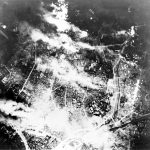 World War II had dragged on long enough. The Axis of Evil nations didn’t seem to care how many of their own people were killed, as long as victory was theirs…typical of any evil nation. It was time to put a stop to this, and the United States, along with the Allied Nations, could see no other solution to the problem, other than fighting fire with fire…literally. This would be the beginning of a horrible new kind of warfare. I’m sure they didn’t come to that decision lightly. While the Japanese were our enemies, the civilian people didn’t really have much say in what they did. Nevertheless, in a war, sometimes civilians are killed. Collateral damage, they call it. It’s a term for deaths, injuries, or other damage inflicted on an unintended target. In American military terminology, it is used for the incidental killing or wounding of non-combatants or damage to non-combatant property during an attack on a legitimate military target. Knowing that the loss of civilian lives is considered “acceptable” in a war, doesn’t make it easy to live with.
World War II had dragged on long enough. The Axis of Evil nations didn’t seem to care how many of their own people were killed, as long as victory was theirs…typical of any evil nation. It was time to put a stop to this, and the United States, along with the Allied Nations, could see no other solution to the problem, other than fighting fire with fire…literally. This would be the beginning of a horrible new kind of warfare. I’m sure they didn’t come to that decision lightly. While the Japanese were our enemies, the civilian people didn’t really have much say in what they did. Nevertheless, in a war, sometimes civilians are killed. Collateral damage, they call it. It’s a term for deaths, injuries, or other damage inflicted on an unintended target. In American military terminology, it is used for the incidental killing or wounding of non-combatants or damage to non-combatant property during an attack on a legitimate military target. Knowing that the loss of civilian lives is considered “acceptable” in a war, doesn’t make it easy to live with.
The prospect was sickening, but something had to be done. So, on March 10, 1945, 300 American bombers  continue to drop almost 2,000 tons of incendiaries on Tokyo, Japan, in a mission that had begun the previous day. The attack destroyed large portions of the Japanese capital and killed 100,000 civilians. Early in the morning on March 10th, the B-29s dropped their bombs of napalm and magnesium incendiaries over the packed residential districts along the Sumida River in eastern Tokyo. The resulting inferno quickly engulfed Tokyo’s wooden residential structures, and the subsequent firestorm replaced oxygen with lethal gases, superheated the atmosphere, and caused hurricane-like winds that blew a wall of fire across the city. The majority of the 100,000 who perished died from carbon monoxide poisoning and the sudden lack of oxygen, but others died horrible deaths within the firestorm, such as those who attempted to find protection in the Sumida River and were boiled alive, or those who were trampled to death in the rush to escape the burning city. As a result of the attack, 10 square miles of eastern Tokyo were entirely obliterated, and an estimated 250,000 buildings were destroyed. When I think about the loss of life brought on by a complete lack of the Japanese government to surrender when they should have.
continue to drop almost 2,000 tons of incendiaries on Tokyo, Japan, in a mission that had begun the previous day. The attack destroyed large portions of the Japanese capital and killed 100,000 civilians. Early in the morning on March 10th, the B-29s dropped their bombs of napalm and magnesium incendiaries over the packed residential districts along the Sumida River in eastern Tokyo. The resulting inferno quickly engulfed Tokyo’s wooden residential structures, and the subsequent firestorm replaced oxygen with lethal gases, superheated the atmosphere, and caused hurricane-like winds that blew a wall of fire across the city. The majority of the 100,000 who perished died from carbon monoxide poisoning and the sudden lack of oxygen, but others died horrible deaths within the firestorm, such as those who attempted to find protection in the Sumida River and were boiled alive, or those who were trampled to death in the rush to escape the burning city. As a result of the attack, 10 square miles of eastern Tokyo were entirely obliterated, and an estimated 250,000 buildings were destroyed. When I think about the loss of life brought on by a complete lack of the Japanese government to surrender when they should have.
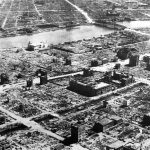
This type of bombing was known as area bombing, and was designed to break Japanese morale and force a surrender. I would imagine that morale was seriously broken after such devastating loss of life and property. The firebombing of Tokyo was the first major firebombing operation of this kind against Japan. Over the next nine days, United States bombers flew similar missions against Nagoya, Osaka, and Kobe. Then in August, United States atomic attacks against Hiroshima and Nagasaki finally forced the Japanese surrender. It was an ugly way to have for fight a war, but the Japanese did not seem to care if their own citizens were sacrificed for their evil cause. All they cared about was winning. Thankfully, they didn’t do that either.

 I was a little girl of three in 1959, when the Barbie doll came out. Every little girl old enough to understand what these dolls were, wanted one…me included. There was one little problem. I just couldn’t seem to get the name right. I told my parents that I wanted a Bride doll. In fact I think I told them that every day for the three months before the arrival of Christmas. Advertisements for the Barbie doll did nothing to deter my quest for a Bride doll. I just didn’t understand that there was going to be a problem.
I was a little girl of three in 1959, when the Barbie doll came out. Every little girl old enough to understand what these dolls were, wanted one…me included. There was one little problem. I just couldn’t seem to get the name right. I told my parents that I wanted a Bride doll. In fact I think I told them that every day for the three months before the arrival of Christmas. Advertisements for the Barbie doll did nothing to deter my quest for a Bride doll. I just didn’t understand that there was going to be a problem.
The Barbie doll made its first appearance on this day, March 9, 1959 at the American Toy Fair in New York City…just like any other supermodel, I suppose. The doll was just stunning, and over the years has been at the center of the self esteem controversy, because some people felt like she gave girls a misguided view of what their bodies should look like. I suppose the doll could have done that, but it certainly did not affect her popularity. In retrospect, I don’t recall that I ever once looked at the doll and decided that I was fat. It was a doll after all, but somewhere along the way, someone must have, so the controversy continues to this day. 
At eleven inches tall, Barbie had beautiful blond hair. Barbie was the first mass-produced toy doll in the United States with adult features. It makes sense. A baby doll can’t play the part of the mom, so if girls were to continue to play with dolls, they had to have a mom…reasoned Ruth Handler, who came up with the idea. Ruth co-founded Mattel, Inc with her husband in 1945. She saw that her young daughter, Barbara ignore her baby dolls to play make-believe with paper dolls of adult women, and realized there was a niche in the market for a toy that allowed little girls to imagine the future. The line has grown to include Ken, Midge, and Skipper.
Over the years, Barbie generated huge sales. On the positive side, many women saw Barbie as providing an 
 alternative to traditional 1950s gender roles. She has had a series of different jobs, from airline stewardess, doctor, pilot and astronaut to Olympic athlete and even United States presidential candidate. Despite the criticism, sales of Barbie-related merchandise continued to soar. The line topped 1 billion dollars annually by 1993. Since 1959, more than 800 million dolls in the Barbie family have been sold around the world and Barbie is now a bona fide global icon. Eventually, I did get my Barbie doll, and for some reason, I never told my parents about the mix-up. I guess I couldn’t let them think that my Christmas gift had not been what I wanted. Besides that, the Bride doll was very beautiful, although I never played with it as much as I would have played with the Barbie doll.
alternative to traditional 1950s gender roles. She has had a series of different jobs, from airline stewardess, doctor, pilot and astronaut to Olympic athlete and even United States presidential candidate. Despite the criticism, sales of Barbie-related merchandise continued to soar. The line topped 1 billion dollars annually by 1993. Since 1959, more than 800 million dolls in the Barbie family have been sold around the world and Barbie is now a bona fide global icon. Eventually, I did get my Barbie doll, and for some reason, I never told my parents about the mix-up. I guess I couldn’t let them think that my Christmas gift had not been what I wanted. Besides that, the Bride doll was very beautiful, although I never played with it as much as I would have played with the Barbie doll.
 After the March 5, 1946, speech by former British Prime Minister Winston Spencer Churchill, condemning the Soviet Union’s policies in Europe, in which he declared, “From Stettin in the Baltic to Trieste in the Adriatic, an iron curtain has descended across the continent.” It was basically the opening remark that defined the Cold War years, and everyone knew that Russia could not be trusted. I suppose that they were similar to the North Koreans today. The Cold War would continue for the next 45 years. It was a source of concern for a number of United States Presidents over the years, as well as the American people. President Ronald Reagan was one of those presidents.
After the March 5, 1946, speech by former British Prime Minister Winston Spencer Churchill, condemning the Soviet Union’s policies in Europe, in which he declared, “From Stettin in the Baltic to Trieste in the Adriatic, an iron curtain has descended across the continent.” It was basically the opening remark that defined the Cold War years, and everyone knew that Russia could not be trusted. I suppose that they were similar to the North Koreans today. The Cold War would continue for the next 45 years. It was a source of concern for a number of United States Presidents over the years, as well as the American people. President Ronald Reagan was one of those presidents.
On March 8, 1983, while speaking at a convention of the National Association of Evangelicals in Florida, President Ronald Reagan publicly referred to the Soviet Union as an evil empire. It was the second time in his career that President Reagan had made this reference. He had first used the phrase in a 1982 speech at the British House of Commons. Some considered Reagan’s use of the Star Wars film-inspired terminology to be brilliant democratic rhetoric, but then in my opinion there was little about President Reagan that wasn’t brilliant. Of course, there were those within the international diplomatic community who denounced it as irresponsible bombast…typical remarks from those who would appease their enemies, thinking that it would stave off any attack. Most evil nations think of appeasement as a show of weakness…and it doesn’t do much for how the citizens of the good nations feel about their own safety either.
President Reagan was prepared to take an aggressive stance toward the Soviet Union. In his plan, known as the 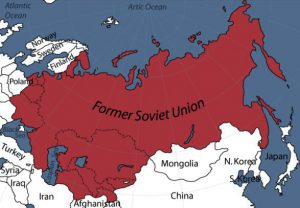 Reagan Doctrine, he warned the nations of the world against what he saw as the dangerous trend of tolerating the Soviets build-up of nuclear weapons and attempts to infiltrate Third World countries in order to spread communism. President Reagan’s policy was basically peace through strength. We had to make the Soviets understand that we would never compromise our principles and standards, nor ignore the facts of history and the aggressive impulses of an evil empire. To do so would mean abandoning the struggle between right and wrong and good and evil, and he knew that must never happen. I think we, the nations of the world, have seen just how detrimental a weak security stance can be given the current mess we are digging out of.
Reagan Doctrine, he warned the nations of the world against what he saw as the dangerous trend of tolerating the Soviets build-up of nuclear weapons and attempts to infiltrate Third World countries in order to spread communism. President Reagan’s policy was basically peace through strength. We had to make the Soviets understand that we would never compromise our principles and standards, nor ignore the facts of history and the aggressive impulses of an evil empire. To do so would mean abandoning the struggle between right and wrong and good and evil, and he knew that must never happen. I think we, the nations of the world, have seen just how detrimental a weak security stance can be given the current mess we are digging out of.
Reagan proposed a policy that went beyond the Truman Doctrine of containment, urging active intervention. His plan was to increase United States military spending and, if necessary, to use force to roll back communist expansion in Third World nations. His administration provided military aid to Nicaraguan groups fighting the leftist Sandinista government and gave material support to the Afghan mujahedeen in their ongoing war against Soviets. At the same time, he reassured Americans that he would pursue an understanding with totalitarian powers and cited the United States’ effort to limit missile development as a step toward peace. Reagan’s doctrine came at the same time as a surge in international and domestic protests against the United States-Soviet arms 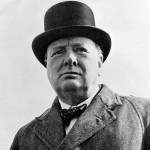 race. His opponents blamed the administration for causing the largest increase in American military spending since the beginning of the Cold War, a policy that swelled the nation’s budget deficit. I suppose that those who just look at the money, might think this was a bad thing, but in the late 1980s the Soviet Union collapsed, ending decades of communist rule in Russia and Eastern Europe. There were those who believed that it had collapsed under the weight of its own bloated defense spending and a protracted war in Afghanistan, but Reagan and his supporters credited his hard-line anti-communist policies for defeating Soviet communism. I am inclined to agree with President Reagan, because I have never believed that we can appease our way to peace and safety in this world.
race. His opponents blamed the administration for causing the largest increase in American military spending since the beginning of the Cold War, a policy that swelled the nation’s budget deficit. I suppose that those who just look at the money, might think this was a bad thing, but in the late 1980s the Soviet Union collapsed, ending decades of communist rule in Russia and Eastern Europe. There were those who believed that it had collapsed under the weight of its own bloated defense spending and a protracted war in Afghanistan, but Reagan and his supporters credited his hard-line anti-communist policies for defeating Soviet communism. I am inclined to agree with President Reagan, because I have never believed that we can appease our way to peace and safety in this world.

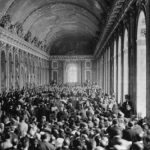 One would expect that after being defeated in a war, it would be understood that you don’t go up against the same adversary again, but apparently this concept was lost on Adolf Hitler. We all know who Hitler was, and that he was bent on taking over the world. There were things about him that had the people of Germany fooled into thinking that he was going to be a great leader, until his Nazi swastika became the symbol of hate and Anti-Semitism. In late June 1914, Archduke Franz Ferdinand of Austria was assassinated by a Serbian nationalist in Sarajevo, Bosnia. An escalation of threats and mobilization orders followed the incident, leading by mid-August to the outbreak of World War I, which pitted Germany, Austria-Hungary and the Ottoman Empire, called the Central Powers, against Great Britain, France, Russia, Italy and Japan, the Allied Powers. The Allies were joined after 1917 by the United States. The Great War, as it was then known, went on for four long years, and saw unprecedented levels of death and destruction, due mostly to grueling trench warfare and the introduction of modern weaponry such as machine guns, tanks and chemical weapons. By the time World War I ended in the defeat of the Central Powers in November 1918, more than 9 million soldiers had been killed and 21 million more were wounded. It makes me cringe to think of the good men lost because of hatred.
One would expect that after being defeated in a war, it would be understood that you don’t go up against the same adversary again, but apparently this concept was lost on Adolf Hitler. We all know who Hitler was, and that he was bent on taking over the world. There were things about him that had the people of Germany fooled into thinking that he was going to be a great leader, until his Nazi swastika became the symbol of hate and Anti-Semitism. In late June 1914, Archduke Franz Ferdinand of Austria was assassinated by a Serbian nationalist in Sarajevo, Bosnia. An escalation of threats and mobilization orders followed the incident, leading by mid-August to the outbreak of World War I, which pitted Germany, Austria-Hungary and the Ottoman Empire, called the Central Powers, against Great Britain, France, Russia, Italy and Japan, the Allied Powers. The Allies were joined after 1917 by the United States. The Great War, as it was then known, went on for four long years, and saw unprecedented levels of death and destruction, due mostly to grueling trench warfare and the introduction of modern weaponry such as machine guns, tanks and chemical weapons. By the time World War I ended in the defeat of the Central Powers in November 1918, more than 9 million soldiers had been killed and 21 million more were wounded. It makes me cringe to think of the good men lost because of hatred.
In July 1919, just eight months after the end of World War I, the Treaty of Versailles was signed, calling for stiff war reparation payments and other punishing peace terms for a defeated Germany. Having been forced to sign the treaty, the German delegation to the peace conference indicated its attitude by breaking the ceremonial pen. In my mind, that was indicative of what was to come. They felt like they shouldn’t have had to surrender or sign such an agreement, and they were telling the world that at some point they would break that treaty. As dictated by the Treaty of Versailles, Germany’s military forces were reduced to insignificance and the Rhineland, along the western border of Germany, was to be demilitarized. Nazi leader Adolf Hitler, well known for his hatred of authority, and for his lack of good sense as it turns out, would violate the Treaty of Versailles and the Locarno Pact by sending German military forces into the Rhineland just four years later.
By 1923, Adolf Hitler and the Nazi Party had seized full power in Germany, removing the rights of the people to have any say in their lives or in government. Hitler promised vengeance against the Allied nations that had 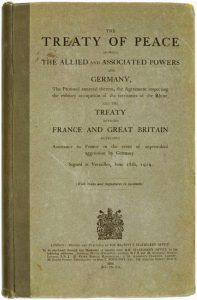
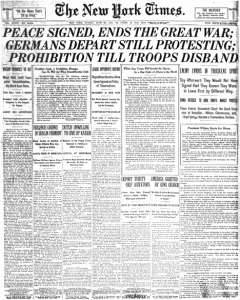 forced the Treaty of Versailles on the German people. In my opinion, the German people had nothing to do with it. The problem with the Treaty of Versailles and the Locarno Pact was Hitler’s on dislike of authority. In 1935, Hitler unilaterally canceled the military clauses of the treaty and in March 1936 denounced the Locarno Pact and began the remilitarizing of the Rhineland. Two years later, Nazi Germany burst out of its territories, absorbing Austria and portions of Czechoslovakia. In 1939, Hitler invaded Poland, leading to the outbreak of World War II in Europe. Hitler would be defeated in World War II, just as he was in World War I, and his suicide and complete show of cowardice would prove that he was not only hateful, but incredibly stupid as well.
forced the Treaty of Versailles on the German people. In my opinion, the German people had nothing to do with it. The problem with the Treaty of Versailles and the Locarno Pact was Hitler’s on dislike of authority. In 1935, Hitler unilaterally canceled the military clauses of the treaty and in March 1936 denounced the Locarno Pact and began the remilitarizing of the Rhineland. Two years later, Nazi Germany burst out of its territories, absorbing Austria and portions of Czechoslovakia. In 1939, Hitler invaded Poland, leading to the outbreak of World War II in Europe. Hitler would be defeated in World War II, just as he was in World War I, and his suicide and complete show of cowardice would prove that he was not only hateful, but incredibly stupid as well.

 Most of us have heard the name Sandy Hook because of the school shooting that took place in an elementary school with the same name in Newtown, Connecticut. That tragedy was not the first time the name Sandy Hook had been at the center of attention, however. Most people know that along United States coastal areas, there are many lighthouses. The lighthouses might not be so necessary these days, because of GPS tracking, but before all of the technology that we have today, lighthouses were the only way for a ship to know if they were coming dangerously close to a stretch of land. Such was the case with the Sandy Hook lighthouse in 1776. The problem they were having with the lighthouse, however, is that it was thought that the lighthouse would also help the British ships to invade New York City. It was a very real concern, and posed a grave danger to the Provincial Congress of New York.
Most of us have heard the name Sandy Hook because of the school shooting that took place in an elementary school with the same name in Newtown, Connecticut. That tragedy was not the first time the name Sandy Hook had been at the center of attention, however. Most people know that along United States coastal areas, there are many lighthouses. The lighthouses might not be so necessary these days, because of GPS tracking, but before all of the technology that we have today, lighthouses were the only way for a ship to know if they were coming dangerously close to a stretch of land. Such was the case with the Sandy Hook lighthouse in 1776. The problem they were having with the lighthouse, however, is that it was thought that the lighthouse would also help the British ships to invade New York City. It was a very real concern, and posed a grave danger to the Provincial Congress of New York.
The Sandy Hook lighthouse was located on a piece of land that was disputed territory in those days. The land sits directly across the bay from New York City, making it an important shipping lane, but a dangerous one too. In early 1761, the Provincial Congress of New York set up lotteries to raise money for the construction of a lighthouse. A lighthouse in this area had been under discussion for nearly a century before it was initiated by Colonial Governor Edmund Andread. Forty three New York merchants proposed the lotteries to the Provincial Council, after losing 20,000 sterling pounds to shipwrecks in 1761. The money was collected, and the Sandy Hook lighthouse was built. It first shone its beam on June 11, 1764. It served it’s purpose quite well…in fact maybe too well…at least during the Revolutionary War. Ships weren’t sinking, but in a big way, it left New York City quite vulnerable to attack. So, after just fifteen years of use, the New York Provincial Congress decided that the lighthouse had to be dismantled. Then came the controversy. A committee of the New York Provincial Congress told Major William Malcolm to “use your best discretion to render the light-house entirely useless.” They wanted him to remove the lens and lamps so that the lighthouse could no longer warn ships of possible hazards on the rocky shore. He succeeded. Colonel George Taylor reported to the committee six days later, that Malcolm had given him eight copper lamps, two tackle falls and blocks, three casks, and a part of a cast of oil from the dismantling of the beacon.
Malcolm’s efforts failed, because the lighthouse was quickly put back into service by the merchants in the area, with the installation of lamps and reflectors. The Patriots attempted to knock the light out again on June 1st, by placing cannon on boats and attempting to blow away the British paraphernalia, damaging some of it before 
 they were chased away. Malcolm’s efforts did not prevent the British from invading New York City. The new states of New York and New Jersey fought over ownership of the lighthouse until the federal government assumed control of all US lighthouses in 1787. As of 1996, the Sandy Hook lighthouse, the oldest original lighthouse in the United States, became a historic landmark, and passed into the jurisdiction of the National Park Service. It is still in operation as part of the Gateway National Recreation Area.
they were chased away. Malcolm’s efforts did not prevent the British from invading New York City. The new states of New York and New Jersey fought over ownership of the lighthouse until the federal government assumed control of all US lighthouses in 1787. As of 1996, the Sandy Hook lighthouse, the oldest original lighthouse in the United States, became a historic landmark, and passed into the jurisdiction of the National Park Service. It is still in operation as part of the Gateway National Recreation Area.
 Anytime a battle is waged between good and evil, there is always innuendo. The evil side always tries to deface the good side by calling them warmongers and racists. It doesn’t matter if the evil side is an evil nation, or an evil group within our own country. Whenever the good side tries to take a stand, they are viewed as racist, haters and warmongers. Not much has changed over the years either. If you think all of these accusations are modern day phenomenon, you are wrong. It’s been going on for many years, and has endured to this day.
Anytime a battle is waged between good and evil, there is always innuendo. The evil side always tries to deface the good side by calling them warmongers and racists. It doesn’t matter if the evil side is an evil nation, or an evil group within our own country. Whenever the good side tries to take a stand, they are viewed as racist, haters and warmongers. Not much has changed over the years either. If you think all of these accusations are modern day phenomenon, you are wrong. It’s been going on for many years, and has endured to this day.
On this day, March 5, 1946, former British Prime Minister Winston Spencer Churchill gave a speech condemning the Soviet Union’s policies in Europe and declared, “From Stettin in the Baltic to Trieste in the Adriatic, an iron curtain has descended across the continent.” Many people thought that Churchill’s speech was one of the opening volleys announcing the beginning of the Cold War. After he was defeated for re-election as prime minister of Great Britain in 1945, Churchill was invited to Westminster College in Fulton, Missouri where he gave his speech. President Harry S  Truman joined him on the platform, listening intently to the speech. Churchill praised the United States as well, declaring it stood “at the pinnacle of world power.” Churchill saw the importance of a closer “special relationship” between the United States and Great Britain…the two great powers of the “English-speaking world” in organizing and policing the post World War II world.
Truman joined him on the platform, listening intently to the speech. Churchill praised the United States as well, declaring it stood “at the pinnacle of world power.” Churchill saw the importance of a closer “special relationship” between the United States and Great Britain…the two great powers of the “English-speaking world” in organizing and policing the post World War II world.
Churchill was worried about the expansionistic policies of the Soviet Union. In addition to the “iron curtain” that had descended across Eastern Europe, Churchill spoke of “communist fifth columns” that were operating throughout western and southern Europe. Churchill drew parallels with the disastrous appeasement of Hitler prior to World War II, and advised that in dealing with the Soviets there was “nothing which they admire so much as strength, and there is nothing for which they have less respect than for military weakness.”
Wisely, Truman and other United States officials received the speech in the spirit it was given. They knew that the Soviet Union was bent on expansion, and that they had to stand tough. Churchill’s “iron curtain” phrase  became a part of the official vocabulary of the Cold War era. Some of the United States officials were less than comfortable with the “special relationship” Churchill had spoken of. They knew that the English were valuable allies for the Cold War, they were also aware of Great Britain’s power, and worried about being used a pawns to help support the crumbling British empire. In the Soviet Union, Russian leader Joseph Stalin denounced the speech as “war mongering,” and referred to Churchill’s comments about the “English-speaking world” as imperialist “racism.” The rhetoric never seems to change, does it. The British, Americans, and Russians, all allies against Hitler less than a year before the speech, were drawing the battle lines of the Cold War…and it would be a long 45 year war, lasting from 1946 to 1991.
became a part of the official vocabulary of the Cold War era. Some of the United States officials were less than comfortable with the “special relationship” Churchill had spoken of. They knew that the English were valuable allies for the Cold War, they were also aware of Great Britain’s power, and worried about being used a pawns to help support the crumbling British empire. In the Soviet Union, Russian leader Joseph Stalin denounced the speech as “war mongering,” and referred to Churchill’s comments about the “English-speaking world” as imperialist “racism.” The rhetoric never seems to change, does it. The British, Americans, and Russians, all allies against Hitler less than a year before the speech, were drawing the battle lines of the Cold War…and it would be a long 45 year war, lasting from 1946 to 1991.

 For years, my brother-in-law, Ron Schulenberg looked for the right woman…one who wanted to be a faithful partner to him, like he would be for them. He had been disappointed over and over…until he met Rachel Franklin. Ron was introduced to Rachel by our niece, Machelle Moore. Machelle saw something in both Rachel and Ron, that she knew was compatible. Both of them had been through the same struggles. The people they had been with before just weren’t good enough for them. Those people didn’t deserve Rachel or Ron, because they weren’t faithful, kind, or loving. This relationship was going to be different…better, wonderful. This relationship was going to be blessed by God, and after almost seven years of marriage, I can say that they are both very happy.
For years, my brother-in-law, Ron Schulenberg looked for the right woman…one who wanted to be a faithful partner to him, like he would be for them. He had been disappointed over and over…until he met Rachel Franklin. Ron was introduced to Rachel by our niece, Machelle Moore. Machelle saw something in both Rachel and Ron, that she knew was compatible. Both of them had been through the same struggles. The people they had been with before just weren’t good enough for them. Those people didn’t deserve Rachel or Ron, because they weren’t faithful, kind, or loving. This relationship was going to be different…better, wonderful. This relationship was going to be blessed by God, and after almost seven years of marriage, I can say that they are both very happy.
Rachel is the mother of three children, Cassie Iverson, Riley Birky, and Tucker Birky, and grandma to Lucas and Zoey Iverson. Her children and grandchildren are of paramount importance to her. She celebrates their accomplishments, prays over their needs, and worries about them when things go wrong. I know, that sounds like a typical mom and grandma, and she is, but for the years that I have known Rachel, I have watched her go through a number of things that might really try the average mom and grandma. Nevertheless, when the need arises, she reaches out to a core group of people that she knows will support her in prayer, no matter what the need might be. Rachel’s grandson, Lucas was born with Downs Syndrome and some other health issues that are only now coming to light, and with Lucas health problems have come many trials, and the need for much prayer. Nevertheless, her faith, while shaken, has never failed. And, I know that God will never fail her.

 Life gets hectic for Rachel at times, but she always wears a smile on her face, and while her smile might hide a degree of worry, it is always genuine. Rachel is such a loving giving person, that it makes me sad to think that some things are a source of worry for her. Rachel is truly a happy, sunny person, and she makes my brother-in-law so happy. They are perfect companions, and I’m thankful that with Rachel came the family that Ron has always wanted. She is a wonderful addition to his family and to ours. Today is Rachel’s birthday. Happy birthday Rachel!! Have a great day!! We love you!!
Life gets hectic for Rachel at times, but she always wears a smile on her face, and while her smile might hide a degree of worry, it is always genuine. Rachel is such a loving giving person, that it makes me sad to think that some things are a source of worry for her. Rachel is truly a happy, sunny person, and she makes my brother-in-law so happy. They are perfect companions, and I’m thankful that with Rachel came the family that Ron has always wanted. She is a wonderful addition to his family and to ours. Today is Rachel’s birthday. Happy birthday Rachel!! Have a great day!! We love you!!
 My grand nephew, Jake Collett joined our family when he married my grand niece, Katy Balcerzak. Jake and Katy are perfect for each other. When they aren’t at work, they are together. It doesn’t matter what it is…errands, visiting family or friends, or just hanging out. They are a team, and that is the best thing to be in a marriage. People who really love each other always seem to be going the in the same direction. Their goals and activities all seem to be along the same lines. That’s Jake and Katy. Just looking at their faces, when they are together, you can see the love they have for each other. It’s just so awesome to watch.
My grand nephew, Jake Collett joined our family when he married my grand niece, Katy Balcerzak. Jake and Katy are perfect for each other. When they aren’t at work, they are together. It doesn’t matter what it is…errands, visiting family or friends, or just hanging out. They are a team, and that is the best thing to be in a marriage. People who really love each other always seem to be going the in the same direction. Their goals and activities all seem to be along the same lines. That’s Jake and Katy. Just looking at their faces, when they are together, you can see the love they have for each other. It’s just so awesome to watch.
Jake and Katy love all things outdoors. It doesn’t matter if its the mountain or the lake. They are there. They love going for long walks on the mountain, and taking their dogs  with them. Hiking is such a beautiful sport, and anyone who does it, knows the peace and serenity of the outdoors. You can’t spend much time out there, and not be hooked for life. Exploring through the trees, finding out what is just around the bend in the trail…that’s what it’s all about. Jake and Katy get that. The mountains and trails are the perfect place to unplug from life and reconnect with your spouse. And that’s what they do…often.
with them. Hiking is such a beautiful sport, and anyone who does it, knows the peace and serenity of the outdoors. You can’t spend much time out there, and not be hooked for life. Exploring through the trees, finding out what is just around the bend in the trail…that’s what it’s all about. Jake and Katy get that. The mountains and trails are the perfect place to unplug from life and reconnect with your spouse. And that’s what they do…often.
 Jake and Katy also love to ride four wheelers. That way they can get even further from the hustle and bustle of their busy lives. There is nothing like heading out into the trees far from the highway and the crowds. These days so many people don’t take time to get back to nature, and I think that is sad. Jake and Katy take lots of pictures of their adventures, and their puppies, Bubba and Sheiba. I like that they post their pictures so everyone else can share in their peaceful times together. I know that they are going to have such a wonderful life, and I’m so happy that they have each other, and that we have been blessed with the addition of Jake to our family. Today is Jake’s birthday. Happy birthday Jake!! Have a great day!! We love you!!
Jake and Katy also love to ride four wheelers. That way they can get even further from the hustle and bustle of their busy lives. There is nothing like heading out into the trees far from the highway and the crowds. These days so many people don’t take time to get back to nature, and I think that is sad. Jake and Katy take lots of pictures of their adventures, and their puppies, Bubba and Sheiba. I like that they post their pictures so everyone else can share in their peaceful times together. I know that they are going to have such a wonderful life, and I’m so happy that they have each other, and that we have been blessed with the addition of Jake to our family. Today is Jake’s birthday. Happy birthday Jake!! Have a great day!! We love you!!
 When a girl turns nine, things really start to change. For my grand niece, Kaytlyn Griffith, that means that she is on the big kid side of the school. That brings back so many memories for me. I hadn’t thought about the big kid side of the school in years. I think I almost thought it was only something that was a part of the school I went to, so to hear that it is still such a big deal is really amazing. It takes me back in time. Kaytlyn really likes school, and does especially well in math and reading. This year she is learning cursive…more things that being on the big kid side of the school is all about. It’s almost like a secret club that kids get to join when they enter the third grade.
When a girl turns nine, things really start to change. For my grand niece, Kaytlyn Griffith, that means that she is on the big kid side of the school. That brings back so many memories for me. I hadn’t thought about the big kid side of the school in years. I think I almost thought it was only something that was a part of the school I went to, so to hear that it is still such a big deal is really amazing. It takes me back in time. Kaytlyn really likes school, and does especially well in math and reading. This year she is learning cursive…more things that being on the big kid side of the school is all about. It’s almost like a secret club that kids get to join when they enter the third grade.
In recent years, a new phenomenon has come into being. Or maybe it was a thing before and has now made a comeback, but when I was a kid and when I was raising my kids, there was no such thing as a Daddy-Daughter Dance. I kind of wish there had been, because it is really a cool way for dads to bond with their daughters. Kaytlyn really wanted her daddy, Josh Griffith to take her and her sister, Jala Satterwhite, last year, but something came up and he couldn’t go. This year Jala wasn’t interested, but Josh and Kaytlyn went to the dance, and I  think Kaytlyn looked just like Cinderella with her Prince Charming. The coolest part of the whole thing was that their picture turned up on the front page of the newspaper. I guess they thought the same thing I did about this royal couple. For Kaytlyn, being on the front page of the paper is the epitome of fame…and she has arrived.
think Kaytlyn looked just like Cinderella with her Prince Charming. The coolest part of the whole thing was that their picture turned up on the front page of the newspaper. I guess they thought the same thing I did about this royal couple. For Kaytlyn, being on the front page of the paper is the epitome of fame…and she has arrived.
I imagine that the reason she feels that way is that one of the commercial loan officers at the First Bank of Wyoming in Powell, Becky Duran is on billboards all over town. Everyone knows her name, and to Kaytlyn, that makes her that most awesome celebrity ever. Sometimes she is even in the paper too. Every time they pass a billboard with her name on it, Kaytlyn shouts, “There’s Becky Duran!” Kaytlyn has loved this celebrity for over a year, and her mom, Susan decided that it was time they met. She made an appointment with Becky, and had her mom, Debbie Cook take the girls in. They were both very excited. She gave them bags of promotional bank  items and they got to have hot chocolate with her. It was a day to remember for both of the girls, and how sweet of Becky to make it such a wonderful memory for them to cherish.
items and they got to have hot chocolate with her. It was a day to remember for both of the girls, and how sweet of Becky to make it such a wonderful memory for them to cherish.
Living in the country has it’s privileges…especially when it comes to pets. Kaytlyn loves her pets. The family has 4 cats and 3 dogs, which might seem like a lot to city dwellers, but in the country, you can do that. Two kittens and a puppy were added to the family in the same weekend. They were all 8 weeks old in November. Since then, it has been pretty crazy around their house. The puppy is named Trump, and I love that. A couple weeks later they found out that he is deaf, but he is the sweetest dog, and well behaved, which is uncommon for a dog that cannot hear commands. Kaytlyn has nicknamed him Truck. Today is Kaytlyn’s 9th birthday. Happy birthday Kaytlyn!! Have a great day!! We love you!!

